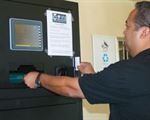
 Campus diners who take out their meals are helping save the environment one container at a time.
Campus diners who take out their meals are helping save the environment one container at a time.
UC Merced is the first campus west of the Mississippi to use the new OZZI container-recycling system, and in just the week since the container-collection machine was placed in the dining commons, the program has become very popular.
“The students are asking about it, they want to know how it works, and they are very excited when we explain it to them,” said Abraham Cereno, the campus’s CatCard manager. “When we tell them we are the first campus in the West to use this, they are like ‘Go Bobcats!’ They want to make a difference.”
And they will – last year, the campus went through about a quarter million take-out containers, including the three-compartment Blue Plate containers, disposable salad bowls, and the paper carriers that hold burgers and fries, chicken strips and other items. Soon, the only option for people who want take-out from the dining hall will be the new green containers.
The reuse program isn’t just for students, though. It’s for anyone who buys a meal at the dining commons with the intent of taking it outside the dining area.
Here’s how the program works: The first time you buy a to-go dish, you pay $5 for the green plastic container the food comes in. You return the used container, and you get either a token for the next one, or a credit on your meal plan. At the end of the year, if you have a token or credit left, you can get your last meal, turn in your token or swipe your card, and you’ll get that initial $5 credited back to your meal plan.
If you get that final credit, the program ends up costing you nothing, saving quite a lot of money compared to paying the 50-cents-per-meal take-out surcharge the dining commons was charging to cover the cost of compostable take-out containers.
Cereno is programming the OZZI machine to swipe CatCards so no one will have to carry tokens. However, the tokens will still remain in use for people without meal-plan cards.
UC Merced is also the first campus to integrate the machines with meal-plan cards, said Jason Souza, director of dining services and the CatCard.
“We’re pioneering this technology, and working with the company’s programmers because this wasn’t offered and isn’t being done on any other campus,” he said. Five other schools, all on the East Coast, also have 12 OZZI machines between them.
The machine in the dining commons should accept Cat Cards next week, but is working with tokens right now. In fact, the machine started with 500 tokens on Move-In Day, and nearly all of them were gone by Wednesday.
Although the green containers are durable – they and the bar codes that come on the bottom of each so purchases can be tracked will last for about 200 washings before they are recycled again – they are not meant to be washed by students and reused. They must be sanitized between uses by Dining Services.
Freshman Mykolas Dargis said he likes the containers because they seem sturdy and hold plenty of food, and he likes being part of a recycling-and-reuse program.
“It’s a great program,” he said, “and they know what they are doing. It seems really well thought out.”
Over the next couple of months, two or three more OZZI machines will be installed, one in the residence halls and one more in the dining commons, and, likely, one in the North section of campus near the library to make it convenient for everyone. If needed, a fifth machine will go in the residence hall that’s now under construction.
The program, Souza said, is a way of recognizing that take-out is a culture that is not going away.
“People are busy. They don’t always have time to sit down in here and eat in. But this way, they can do what they need to do and still feel good about helping the environment,” Souza said.
The goal is the drastic reduction or elimination of disposable containers to help meet the campus’s Zero Net Waste pledge.
“This is just the first layer of the program,” Souza said. He said he anticipates 50,000 uses and returns this school year, and while it could save the campus some money, that’s not why he and Cereno are so passionate about it.
“It’s the right thing to do,” Souza said. “I want this to be our legacy for the campus.”
Lorena Anderson

Senior Writer and Public Information Representative
Office: (209) 228-4406
Mobile: (209) 201-6255






